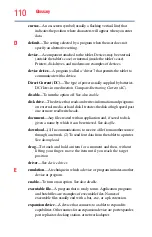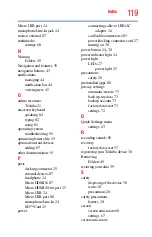
Glossary
113
N
network
—A collection of computers and associated devices that are
connected by communications facilities. A network allows you to
share data and peripheral devices, such as printers, with other users
and to exchange electronic mail.
non-interlaced
—A method of refreshing the tablet screen, in which
each pixel of every line is refreshed as the electron beam scans
across and down the screen. Compare
interlaced.
O
online
—Available through a computer. Online may refer to information
being read from your own computer’s internal storage drive, such
as online documentation or online Help, or to information coming
from another company on a company network or the Internet.
operating system
—A set of programs that controls how the tablet
device works.
P
password
—A unique string of characters entered by a user to verify his
or her identity to a computer or the network.
peripheral
—Any device, such as a mouse or keyboard, that is attached
to the tablet and controlled by the tablet’s CPU.
pixel
—Short for “picture element.” The smallest dot that can be
produced on a screen or printer.
Plug and Play
—Generally, refers to the tablet’s ability to automatically
configure itself to work with peripheral devices. When capitalized,
refers to a standard that, when followed by a device manufacturer,
allows the tablet to configure itself automatically to work with the
device.
port
—A socket on the tablet where you plug in a cable for connection to
a peripheral device.
processor
—See
Central Processing Unit (CPU)
.
properties
—The attributes of an object or device. For example, the
properties of a file include the file’s type, size, and creation date.
R
RAM (Random Access Memory)
—
Volatile
memory that can be
written to as well as read.
Volatile
here means that information in
RAM is lost when you turn off your tablet. This type of memory is
used for your tablet’s main memory. See also
memory
.
Compare
ROM.
Random Access Memory
—See
RAM.










































